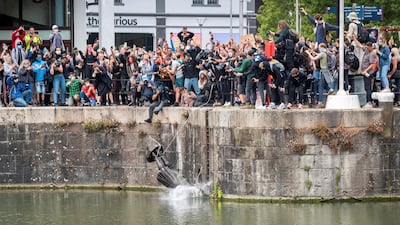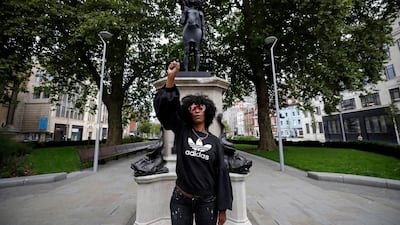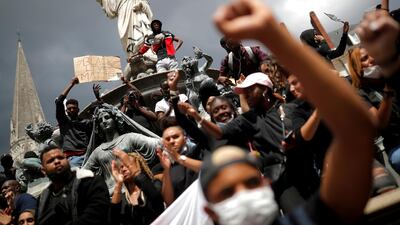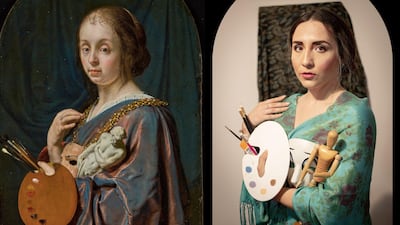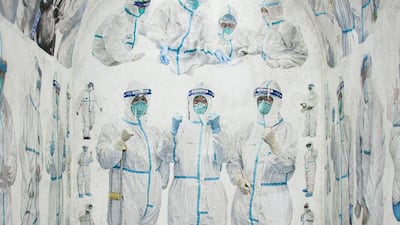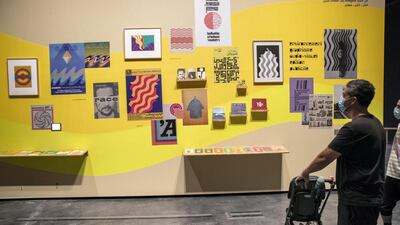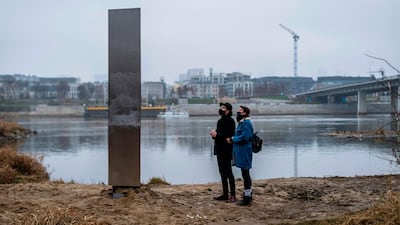It has been a challenging year for the arts. Despite the migration of events to the digital realm, artists and art spaces have grappled with financial downturns, while institutions have been pushed to confront their legacies of violence and exclusion.
As 2020 comes to close, here are the biggest moments in the art world, the effects of which will continue to shape how we experience, think about or talk about art in the year to come.
Closed and cancelled
It started with Art Basel Hong Kong, the first major art fair to be cancelled as the coronavirus made its way around the world. The Asian edition of the mammoth international art event was called off in February, ahead of its March schedule. Others soon followed suit – in the UAE, Art Dubai eventually adapted to a virtual fair, while Sharjah Art Foundation's March Meeting was postponed, with new 2021 dates only recently announced. Big fairs such as Frieze in New York and Art Basel in Switzerland and Miami also moved to the digital world.
Alongside the cancellations were the closures, from the Met and the Museum of Modern Art in New York to the Tate galleries, Victoria and Albert Museum and British Museum in the UK. Museums in Europe and the UK have since gone into on-and-off closures as the second wave of the virus struck in the autumn months.
In the UAE, Louvre Abu Dhabi, Jameel Arts Centre, Sharjah Art Museum and Alserkal Avenue's galleries were shuttered in March too. Cultural spaces began to reopen in May and June, and are now welcoming guests in limited capacities.
Going virtual
With spaces closed and international travel restrictions in place, arts and culture migrated to the digital realm. The internet was awash with virtual exhibitions and art fairs, online workshops and symposia, in many ways making us more connected than before. Notable virtual events included the Metropolitan Opera streaming performances from its archives for free, while the British Museum offered a virtual walk-through of its space.
The art of the online challenge
Online challenges caught on in the arts, such as the widespread Getty Museum Challenge, which asked the public to recreate famous artworks at home. Submissions came pouring in, with household items and pets creatively transformed into props or subjects.
There was also the #CuratorBattle by the Yorkshire Museum in the UK, which asked other institutions to show off their collections under themes such as "creepiest object" and "sassiest object".
Impact of Black Lives Matter
Conversations around race and systemic discrimination in the art world came to the fore in the wake of George Floyd's murder in May. While protests were filling the streets, the debate around monuments in the West and Confederate statues in the US raged – are they key historical reminders or do they glorify former oppressors?
In Bristol, protesters toppled the statue of slave trader Edward Colston in June, while statues of Thomas Jefferson and Christopher Columbus were also taken down in US cities.
Most recently, a statue of Robert E Lee, a confederate general, was removed from the US Capitol. It will be replaced by one of Barbara Johns, a civil rights leader who led a student strike for equal rights in 1951.
Museums were quick to try to respond to the moment, though not always successfully. In the case of the Whitney Museum of American Art, controversy erupted after the announcement that a show, meant to reflect on the Black Lives Matter movement, would be filled with Black artists' works that were bought from a fundraising initiative. The artists spoke out against what they described as a "predatory" acquisition process, and the exhibition was cancelled.
Museums and money
Amid deepening economic crises, museums and galleries are also feeling the pinch; Unesco has stated that one in eight museums worldwide may be forced to close down due to the pandemic. Many other institutions have been finding ways to stay afloat by deaccessioning their collections or laying off staff.
Both moves have been criticised, the latter especially so. Despite its $3 billion endowment, the Metropolitan Museum of Art has cut 20 per cent of its staff since March as it projects a $150 million loss of revenue due the pandemic.
There have also been mass redundancies in UK institutions: the Tate initially cut 295 jobs from its commercial workforce before announcing it will slash 120 more from its gallery staff; Southbank Centre in London warned of 400 redundancies in June, though it has since rehired a small number this month; and the Royal Academy of Arts plans to cut 40 per cent of its staff. The layoffs have prompted protests in London.
Frustrations around working conditions and diversity combined with the cultural shift spurred by Black Lives Matter have also given rise to anonymous social media accounts that call out unfair practices in the art world.
Accounts such as Change the Museum and Cancel Art Galleries feature stories from former employees exposing racism and abusive behaviour at museums and galleries primarily in the US.
Rise of bailouts and fundraising efforts
These financial losses have compelled public and private players to step up efforts to help, including a $54 billion package from the German federal government for the country’s creative and cultural sectors.
In the region, private entities such as Jameel Arts Centre have announced grants for artists, while Alserkal Avenue waived rent for its cultural tenants for three months.
The UAE also launched the National Creative Relief Programme, offering freelancers and small businesses in the creative field a chance to apply to grants. As of August, the scheme has provided Dh4.6 million in grants to the country's creative sector.
Beirut blast shatters art scene
The devastating Beirut blast in August left the Lebanese capital’s art scene in tatters, with galleries, museums and heritage sites among those heavily damaged. Lebanon’s Ministry of Culture found that at least 8,000 buildings were affected by the explosion, including 640 historic buildings.
In August, Unesco, Louvre Museum in Paris and other international organisations have pledged a "cultural first aid" for Beirut to help restore damaged libraries, historic buildings and museums. Across the region, fundraising efforts by artists and organisations have also contributed to charities and art spaces in Beirut.
Wave of pandemic art
Medical masks have become the symbol of the Covid-19 crisis and ubiquitous in pandemic art. Since March, artists around the world have been responding to this moment in various ways, from tributes to medical workers to visual reminders of solidarity in the face of uncertainty and fear.
Pandemic art had its moment in the spotlight, with the creation of the Covid Art Museum, Banksy's parachuting rats in London and sneezing woman in Bristol, Disney characters practicing social distancing, and many more.
Strides in restitution
In October, activist Emery Mwazulu Diyabanza attempted to take a sculpture from the Louvre in Paris. It was part of a campaign by a pan-African group Unite Dignite Courage, which calls for the restitution of African heritage and artefacts. This incident is part of a larger movement calling for the repatriation of looted objects from European institutions to their countries of origin.
Last month, the French Senate had signed a bill that promises to return 26 sculptures from the Quai Branly Museum to Benin and a sword back to Senegal. In Nigeria, an institution intends to build a new museum over the next four years that could exhibit looted Benin Bronzes currently displayed in European and American museums.
French President Emmanuel Macron has been a supporter of repatriation, tweeting in 2017, “African cultural heritage can no longer remain a prisoner of European museum.” A 2018 report that he commissioned revealed that around 90,000 African works are currently held in French collections, with few ever returned.
In Nigeria, architect David Adjaye is designing a museum meant to house the Benin Bronzes, currently on display at the British Museum and the Ethnological Museum of Berlin. These 1,000 prized metal plaques and sculptures were looted by British troops from the royal palace of the Kingdom of Benin in 1897.
Monolith as meme
Monoliths are cropping up around the world, thanks to a mysterious object that was first discovered in Utah in November. The shiny metal pillar was spotted by a local wildlife agency after a routine inspection of the area via helicopter. When news of the monolith became public, curious individuals began to make their way to the desert to see the object in person.
Less than two weeks later, the monolith was anonymously taken down and copycats began springing up in more US cities, as well as Romania, Sweden, the UK, Germany, New Zealand.
The origins of the first monolith remain unknown, though some have put forward names of artists who may have installed the work as a kind of creative intervention. How or why it has become a global phenomenon is possibly just as strange, though perhaps it is the mystery that keeps it going.
SPECS
%3Cp%3E%3Cstrong%3EEngine%3A%20%3C%2Fstrong%3E2.4-litre%204-cylinder%20turbo%20hybrid%0D%3Cbr%3E%3Cstrong%3EPower%3A%3C%2Fstrong%3E%20366hp%0D%3Cbr%3E%3Cstrong%3ETorque%3A%20%3C%2Fstrong%3E550Nm%0D%3Cbr%3E%3Cstrong%3ETransmission%3A%20%3C%2Fstrong%3ESix-speed%20auto%0D%3Cbr%3E%3Cstrong%3EPrice%3A%3C%2Fstrong%3E%20From%20Dh360%2C000%0D%3Cbr%3E%3Cstrong%3EAvailable%3A%20%3C%2Fstrong%3ENow%0D%3C%2Fp%3E%0A
GAC GS8 Specs
Engine: 2.0-litre 4cyl turbo
Power: 248hp at 5,200rpm
Torque: 400Nm at 1,750-4,000rpm
Transmission: 8-speed auto
Fuel consumption: 9.1L/100km
On sale: Now
Price: From Dh149,900
The specs
- Engine: 3.9-litre twin-turbo V8
- Power: 640hp
- Torque: 760nm
- On sale: 2026
- Price: Not announced yet
Recent winners
2002 Giselle Khoury (Colombia)
2004 Nathalie Nasralla (France)
2005 Catherine Abboud (Oceania)
2007 Grace Bijjani (Mexico)
2008 Carina El-Keddissi (Brazil)
2009 Sara Mansour (Brazil)
2010 Daniella Rahme (Australia)
2011 Maria Farah (Canada)
2012 Cynthia Moukarzel (Kuwait)
2013 Layla Yarak (Australia)
2014 Lia Saad (UAE)
2015 Cynthia Farah (Australia)
2016 Yosmely Massaad (Venezuela)
2017 Dima Safi (Ivory Coast)
2018 Rachel Younan (Australia)
ONCE UPON A TIME IN GAZA
Starring: Nader Abd Alhay, Majd Eid, Ramzi Maqdisi
Directors: Tarzan and Arab Nasser
Rating: 4.5/5
Inside%20Out%202
%3Cp%3E%3Cstrong%3EDirector%3A%C2%A0%3C%2Fstrong%3EKelsey%20Mann%3C%2Fp%3E%0A%3Cp%3E%3Cstrong%3EStarring%3A%3C%2Fstrong%3E%C2%A0Amy%20Poehler%2C%20Maya%20Hawke%2C%20Ayo%20Edebiri%3C%2Fp%3E%0A%3Cp%3E%3Cstrong%3ERating%3A%20%3C%2Fstrong%3E4.5%2F5%3C%2Fp%3E%0A
Tips to stay safe during hot weather
- Stay hydrated: Drink plenty of fluids, especially water. Avoid alcohol and caffeine, which can increase dehydration.
- Seek cool environments: Use air conditioning, fans, or visit community spaces with climate control.
- Limit outdoor activities: Avoid strenuous activity during peak heat. If outside, seek shade and wear a wide-brimmed hat.
- Dress appropriately: Wear lightweight, loose and light-coloured clothing to facilitate heat loss.
- Check on vulnerable people: Regularly check in on elderly neighbours, young children and those with health conditions.
- Home adaptations: Use blinds or curtains to block sunlight, avoid using ovens or stoves, and ventilate living spaces during cooler hours.
- Recognise heat illness: Learn the signs of heat exhaustion and heat stroke (dizziness, confusion, rapid pulse, nausea), and seek medical attention if symptoms occur.
ARM%20IPO%20DETAILS
%3Cp%3E%3Cstrong%3EShare%20price%3A%3C%2Fstrong%3E%20Undisclosed%3C%2Fp%3E%0A%3Cp%3E%3Cstrong%3ETarget%20raise%3A%3C%2Fstrong%3E%20%248%20billion%20to%20%2410%20billion%3C%2Fp%3E%0A%3Cp%3E%3Cstrong%3EProjected%20valuation%3A%3C%2Fstrong%3E%20%2460%20billion%20to%20%2470%20billion%20(Source%3A%20Bloomberg)%3C%2Fp%3E%0A%3Cp%3E%3Cstrong%3ELead%20underwriters%3A%3C%2Fstrong%3E%20Barclays%2C%20Goldman%20Sachs%20Group%2C%20JPMorgan%20Chase%20and%20Mizuho%20Financial%20Group%3C%2Fp%3E%0A
Jawan
%3Cp%3E%3Cstrong%3EDirector%3A%20%3C%2Fstrong%3EAtlee%3C%2Fp%3E%0A%3Cp%3E%3Cstrong%3EStars%3A%3C%2Fstrong%3E%20Shah%20Rukh%20Khan%2C%20Nayanthara%2C%20Vijay%20Sethupathi%26nbsp%3B%3C%2Fp%3E%0A%3Cp%3E%3Cstrong%3ERating%3A%20%3C%2Fstrong%3E4%2F5%3C%2Fp%3E%0A
LIVERPOOL%20TOP%20SCORERS
%3Cp%3E(Premier%20League%20only)%3Cbr%3EMohamed%20Salah%20129%3Cbr%3ERobbie%20Fowler%20128%3Cbr%3ESteven%20Gerrard%20120%3Cbr%3EMichael%20Owen%20118%3Cbr%3ESadio%20Mane%2090%3Cbr%3E%3C%2Fp%3E%0A
Silent Hill f
Publisher: Konami
Platforms: PlayStation 5, Xbox Series X/S, PC
Rating: 4.5/5
UAE currency: the story behind the money in your pockets
Dunki
%3Cp%3E%3Cstrong%3EDirector%3A%3C%2Fstrong%3E%20Rajkumar%20Hirani%C2%A0%3C%2Fp%3E%0A%3Cp%3E%3Cstrong%3EStarring%3A%3C%2Fstrong%3E%20Shah%20Rukh%20Khan%2C%20Taapsee%20Pannu%2C%20Vikram%20Kochhar%20and%20Anil%20Grover%3C%2Fp%3E%0A%3Cp%3E%3Cstrong%3ERating%3A%3C%2Fstrong%3E%204%2F5%3C%2Fp%3E%0A
Explainer: Tanween Design Programme
Non-profit arts studio Tashkeel launched this annual initiative with the intention of supporting budding designers in the UAE. This year, three talents were chosen from hundreds of applicants to be a part of the sixth creative development programme. These are architect Abdulla Al Mulla, interior designer Lana El Samman and graphic designer Yara Habib.
The trio have been guided by experts from the industry over the course of nine months, as they developed their own products that merge their unique styles with traditional elements of Emirati design. This includes laboratory sessions, experimental and collaborative practice, investigation of new business models and evaluation.
It is led by British contemporary design project specialist Helen Voce and mentor Kevin Badni, and offers participants access to experts from across the world, including the likes of UK designer Gareth Neal and multidisciplinary designer and entrepreneur, Sheikh Salem Al Qassimi.
The final pieces are being revealed in a worldwide limited-edition release on the first day of Downtown Designs at Dubai Design Week 2019. Tashkeel will be at stand E31 at the exhibition.
Lisa Ball-Lechgar, deputy director of Tashkeel, said: “The diversity and calibre of the applicants this year … is reflective of the dynamic change that the UAE art and design industry is witnessing, with young creators resolute in making their bold design ideas a reality.”
J%20Street%20Polling%20Results
%3Cp%3E97%25%20of%20Jewish-Americans%20are%20concerned%20about%20the%20rise%20in%20anti-Semitism%3Cbr%3E%3Cbr%3E76%25%20of%20US%20Jewish%20voters%20believe%20Donald%20Trump%20and%20his%20allies%20in%20the%20Republican%20Party%20are%20responsible%20for%20a%20rise%20in%20anti-Semitism%3Cbr%3E%3Cbr%3E74%25%20of%20American%20Jews%20agreed%20that%20%E2%80%9CTrump%20and%20the%20Maga%20movement%20are%20a%20threat%20to%20Jews%20in%20America%22%3Cbr%3E%3C%2Fp%3E%0A
More from Mohammed Alardhi
Winners
Ballon d’Or (Men’s)
Ousmane Dembélé (Paris Saint-Germain / France)
Ballon d’Or Féminin (Women’s)
Aitana Bonmatí (Barcelona / Spain)
Kopa Trophy (Best player under 21 – Men’s)
Lamine Yamal (Barcelona / Spain)
Best Young Women’s Player
Vicky López (Barcelona / Spain)
Yashin Trophy (Best Goalkeeper – Men’s)
Gianluigi Donnarumma (Paris Saint-Germain and Manchester City / Italy)
Best Women’s Goalkeeper
Hannah Hampton (England / Aston Villa and Chelsea)
Men’s Coach of the Year
Luis Enrique (Paris Saint-Germain)
Women’s Coach of the Year
Sarina Wiegman (England)
From Zero
Artist: Linkin Park
Label: Warner Records
Number of tracks: 11
Rating: 4/5
T20 WORLD CUP QUALIFIERS
Qualifier A, Muscat
(All matches to be streamed live on icc.tv)
Fixtures
Friday, February 18: 10am Oman v Nepal, Canada v Philippines; 2pm Ireland v UAE, Germany v Bahrain
Saturday, February 19: 10am Oman v Canada, Nepal v Philippines; 2pm UAE v Germany, Ireland v Bahrain
Monday, February 21: 10am Ireland v Germany, UAE v Bahrain; 2pm Nepal v Canada, Oman v Philippines
Tuesday, February 22: 2pm Semi-finals
Thursday, February 24: 2pm Final
UAE squad:Ahmed Raza(captain), Muhammad Waseem, Chirag Suri, Vriitya Aravind, Rohan Mustafa, Kashif Daud, Zahoor Khan, Alishan Sharafu, Raja Akifullah, Karthik Meiyappan, Junaid Siddique, Basil Hameed, Zafar Farid, Mohammed Boota, Mohammed Usman, Rahul Bhatia
WOMAN AND CHILD
Director: Saeed Roustaee
Starring: Parinaz Izadyar, Payman Maadi
Rating: 4/5
The%20specs
%3Cp%3E%3Cstrong%3EEngine%3A%3C%2Fstrong%3E%201.8-litre%204-cyl%20turbo%0D%3Cbr%3E%3Cstrong%3EPower%3A%20%3C%2Fstrong%3E190hp%20at%205%2C200rpm%0D%3Cbr%3E%3Cstrong%3ETorque%3A%3C%2Fstrong%3E%20320Nm%20from%201%2C800-5%2C000rpm%0D%3Cbr%3E%3Cstrong%3ETransmission%3A%20%3C%2Fstrong%3ESeven-speed%20dual-clutch%20auto%0D%3Cbr%3E%3Cstrong%3EFuel%20consumption%3A%3C%2Fstrong%3E%206.7L%2F100km%0D%3Cbr%3E%3Cstrong%3EPrice%3A%3C%2Fstrong%3E%20From%20Dh111%2C195%0D%3Cbr%3E%3Cstrong%3EOn%20sale%3A%20%3C%2Fstrong%3ENow%3C%2Fp%3E%0A
MATCH INFO
Fixture: Ukraine v Portugal, Monday, 10.45pm (UAE)
TV: BeIN Sports
Switching%20sides
%3Cp%3EMahika%20Gaur%20is%20the%20latest%20Dubai-raised%20athlete%20to%20attain%20top%20honours%20with%20another%20country.%0D%3C%2Fp%3E%0A%3Cp%3E%3Cstrong%3EVelimir%20Stjepanovic%20(Serbia%2C%20swimming)%20%3C%2Fstrong%3E%0D%3Cbr%3EBorn%20in%20Abu%20Dhabi%20and%20raised%20in%20Dubai%2C%20he%20finished%20sixth%20in%20the%20final%20of%20the%202012%20Olympic%20Games%20in%20London%20in%20the%20200m%20butterfly%20final.%20%0D%3C%2Fp%3E%0A%3Cp%3E%3Cstrong%3EJonny%20Macdonald%20(Scotland%2C%20rugby%20union)%20%3C%2Fstrong%3E%0D%3Cbr%3EBrought%20up%20in%20Abu%20Dhabi%20and%20represented%20the%20region%20in%20international%20rugby.%20When%20the%20Arabian%20Gulf%20team%20was%20broken%20up%20into%20its%20constituent%20nations%2C%20he%20opted%20to%20play%20for%20Scotland%20instead%2C%20and%20went%20to%20the%20Hong%20Kong%20Sevens.%20%0D%3C%2Fp%3E%0A%3Cp%3E%3Cstrong%3ESophie%20Shams%20(England%2C%20rugby%20union)%20%3C%2Fstrong%3E%0D%3Cbr%3EThe%20daughter%20of%20an%20English%20mother%20and%20Emirati%20father%2C%20Shams%20excelled%20at%20rugby%20in%20Dubai%2C%20then%20after%20attending%20university%20in%20the%20UK%20played%20for%20England%20at%20sevens.%20%0D%3C%2Fp%3E%0A
COMPANY PROFILE
Name: HyperSpace
Started: 2020
Founders: Alexander Heller, Rama Allen and Desi Gonzalez
Based: Dubai, UAE
Sector: Entertainment
Number of staff: 210
Investment raised: $75 million from investors including Galaxy Interactive, Riyadh Season, Sega Ventures and Apis Venture Partners
Match info:
Portugal 1
Ronaldo (4')
Morocco 0
FIXTURES
Monday, January 28
Iran v Japan, Hazza bin Zayed Stadium (6pm)
Tuesday, January 29
UAEv Qatar, Mohamed Bin Zayed Stadium (6pm)
Friday, February 1
Final, Zayed Sports City Stadium (6pm)
THE%20SPECS
%3Cp%3EBattery%3A%2060kW%20lithium-ion%20phosphate%3Cbr%3EPower%3A%20Up%20to%20201bhp%3Cbr%3E0%20to%20100kph%3A%207.3%20seconds%3Cbr%3ERange%3A%20418km%3Cbr%3EPrice%3A%20From%20Dh149%2C900%3Cbr%3EAvailable%3A%20Now%3C%2Fp%3E%0A
How to apply for a drone permit
- Individuals must register on UAE Drone app or website using their UAE Pass
- Add all their personal details, including name, nationality, passport number, Emiratis ID, email and phone number
- Upload the training certificate from a centre accredited by the GCAA
- Submit their request
What are the regulations?
- Fly it within visual line of sight
- Never over populated areas
- Ensure maximum flying height of 400 feet (122 metres) above ground level is not crossed
- Users must avoid flying over restricted areas listed on the UAE Drone app
- Only fly the drone during the day, and never at night
- Should have a live feed of the drone flight
- Drones must weigh 5 kg or less
Who was Alfred Nobel?
The Nobel Prize was created by wealthy Swedish chemist and entrepreneur Alfred Nobel.
- In his will he dictated that the bulk of his estate should be used to fund "prizes to those who, during the preceding year, have conferred the greatest benefit to humankind".
- Nobel is best known as the inventor of dynamite, but also wrote poetry and drama and could speak Russian, French, English and German by the age of 17. The five original prize categories reflect the interests closest to his heart.
- Nobel died in 1896 but it took until 1901, following a legal battle over his will, before the first prizes were awarded.
UAE currency: the story behind the money in your pockets
COMPANY PROFILE
Name: Rain Management
Year started: 2017
Based: Bahrain
Employees: 100-120
Amount raised: $2.5m from BitMex Ventures and Blockwater. Another $6m raised from MEVP, Coinbase, Vision Ventures, CMT, Jimco and DIFC Fintech Fund
